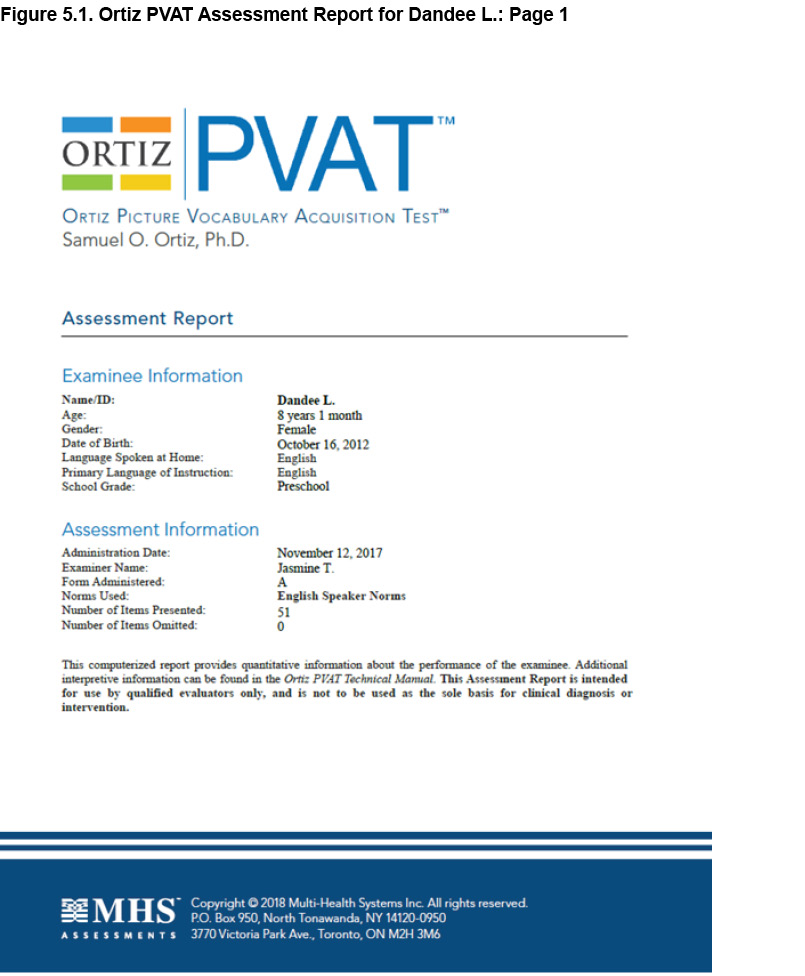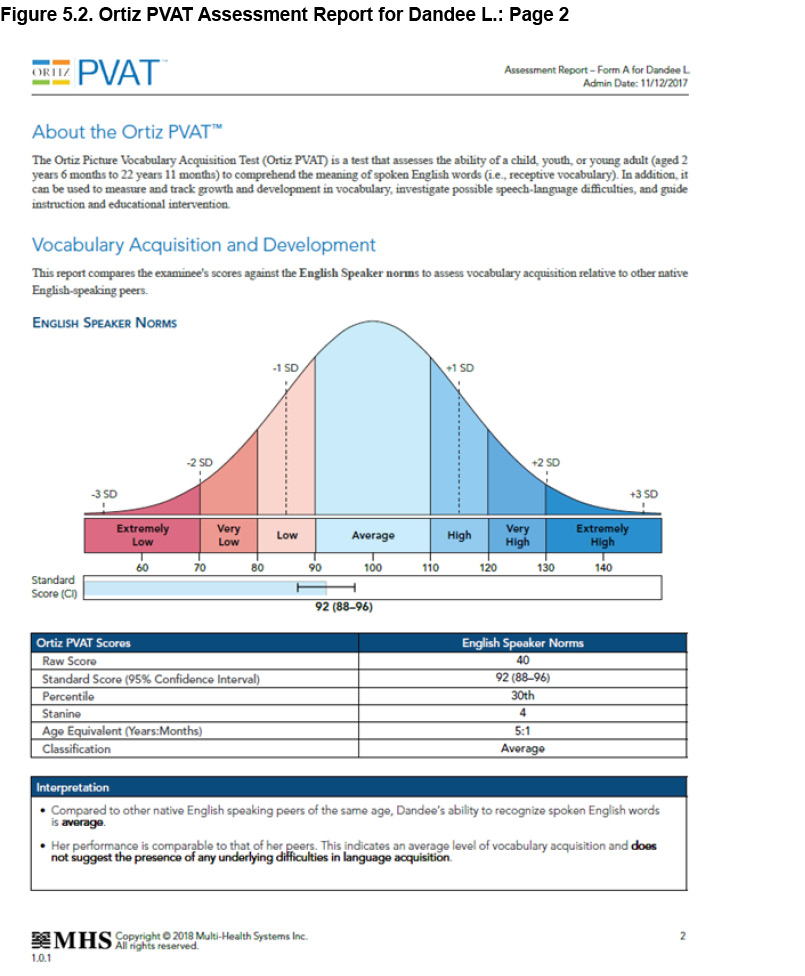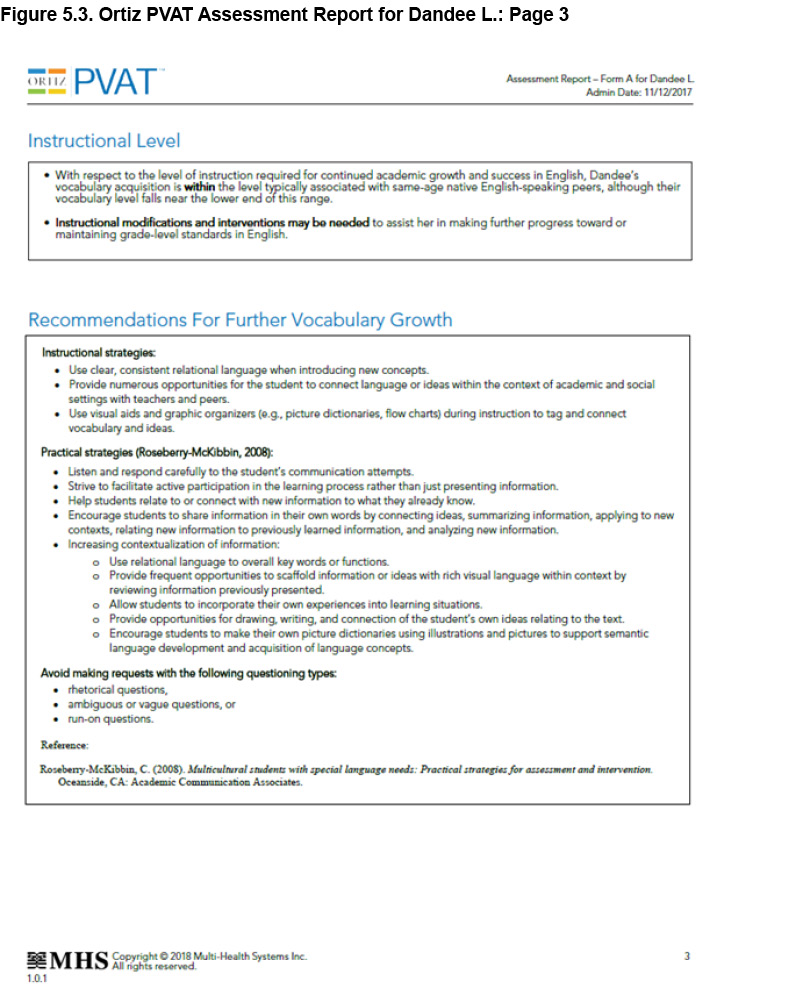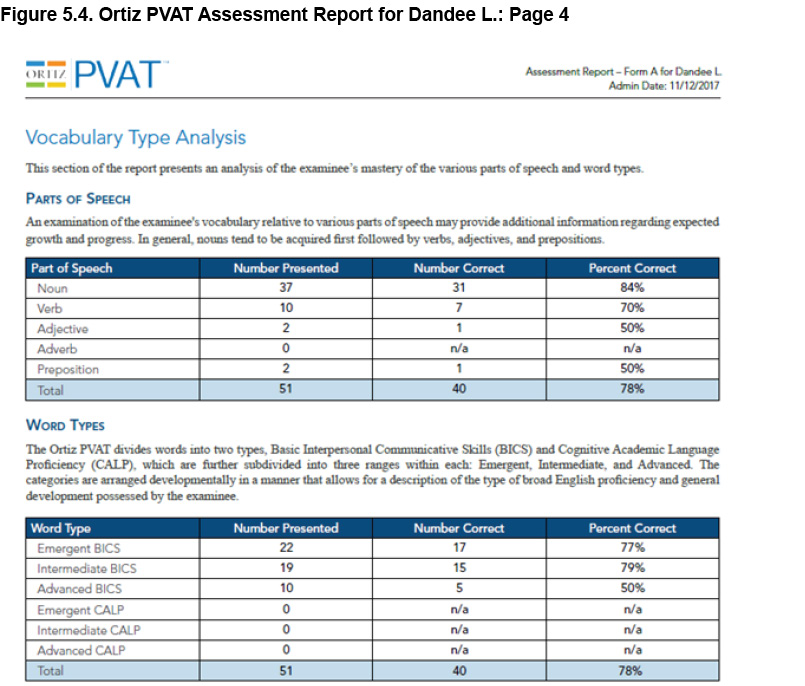- Technical Manual
- Chapter 1: Introduction
- Chapter 2: Theory and Background
- Chapter 3: Administration and Scoring
- Chapter 4: Scores and Interpretation
- Chapter 5: Case Studies
- Overview
- Case Study 1: Clinical Evaluation of an English Speaker Suspected of Having a Speech-Language Impairment
- Case Study 2: Progress Monitoring of an English Learner with Suspected Deficits in Verbal Ability and Language
- Case Study 3: Psychoeducational Evaluation of an English Learner with Suspected Specific Learning Disability
- Chapter 6: Development
- Chapter 7: Standardization
- Chapter 8: Test Standards: Reliability, Validity, and Fairness
- Task Instruction Scripts
Case Study 1: Clinical Evaluation of an English Speaker Suspected of Having a Speech-Language Impairment |
Dandee L. is a child of Anglo-American and distant Japanese heritage who is 5 years 1 month old. Dandee was brought in by her parents for a speech-language evaluation following a referral from teachers at the local preschool she attended for the past two years; the teachers expressed concern regarding a lack of expected language development, including intelligibility, as well as receptive and expressive skills. Because Dandee is about to start kindergarten, her parents wanted to know if there is any language development issue that might require attention as she enters formal schooling.
Dandee was born in Austin, Texas where she and her family have lived for about five generations. Originally, her great-great grandmother emigrated to the U.S. from Japan in the early 1900s, eventually making her way across the country and finally settling in the Austin area where she met and married a local farmer. Despite their American lineage and citizenship, in 1940, Dandee’s great-grandfather and her grandparents on her father’s side were forcibly moved to a nearby internment camp. They were released a few years later, having lost much of their possessions and land. Through successful court actions, they were able to recoup some of their losses and received some reparations from the U.S. government; this allowed the family to establish a new life in Austin, where Dandee’s parents and her grandparents now own a steak restaurant and operate an Asian fusion cuisine food truck. Dandee has no brothers or sisters yet, although her parents indicate they will likely have more children. They also report that they speak English exclusively at home. They have never learned or heard any Japanese, as their parents on both sides (i.e., Dandee’s grandparents) all spoke and were educated in English. It is possible, however, that Dandee’s parents might have spoken or understood some Japanese back then. At present, the family identifies strongly with their American heritage, engaging in all the national holidays and customary activities.
According to Dandee’s parents, they did not previously notice anything in particular regarding her language, but have become more concerned after the observations from her teachers. They are, admittedly, new to parenting and having a child that does not speak very much did not seem entirely out of the ordinary. Both of Dandee’s parents have Bachelor’s degrees and participate in the operation of the restaurant and food truck, but they also spend considerable time at home with Dandee. Prior to starting preschool, she would often accompany them to the restaurant where she was allowed to entertain herself with a tablet or by watching television. Two years ago, at the age of 3 years, Dandee’s parents enrolled her in a preschool program to provide her with more opportunities to interact with other children. It was at this time that they began getting reports concerned with Dandee’s perceived difficulties in listening to instructions, following directions, and a seeming reticence to engage in much verbal interaction. There were no indications of any atypical or unusual behavior apart from what seemed to be a general tendency to be shy and quiet. Nevertheless, her teachers began to express greater concern regarding her lack of developmentally-appropriate expressive language as she continued in preschool. Her parents report that all prior milestones (e.g., initiation of speech, walking, toilet training, self-care) were met without any noticeable delay or problems. There do not appear to have been any relevant issues during pregnancy or delivery, and Dandee has been reported to be in good health since birth with no injuries, surgeries, or chronic illnesses of any kind.
Based on the information provided by Dandee’s parents and the expressed concerns of her preschool teachers, a comprehensive speech-language evaluation was conducted. All areas of functioning were evaluated to determine whether there was any basis for any type of speech-language impairment. An audiological assessment revealed no significant findings; Dandee’s hearing was found to be within normal limits bilaterally. Examination of the tympanic membrane also revealed normal middle ear functioning in both ears and at normal levels. The speech-language pathologist (SLP) would have liked to evaluate for auditory processing disorder; however, most tests that assess for this disorder are developed for children aged 7 or 8 years. In younger children, there is normal but significant variability in brain function that prevents reliable interpretation. Although some auditory tests do reach down to age 5 years, it was decided that none of them would provide an appropriate standardized measure of auditory processing disorder for Dandee. Instead, the speech-language pathologist relied on a language processing checklist that had been designed specifically for preschool children. Information from the checklist did not provide any indication of difficulties in this area. With respect to an evaluation of a possible phonological processing disorder, the Comprehensive Test of Phonological Processing, 2nd Edition (CTOPP-2; Wagner, Torgesen, Rashotte, & Pearson, 2013) was used, but it also failed to reveal any evidence that Dandee might have deficits related to phonological awareness, phonological memory, rapid symbolic, and rapid non-symbolic naming. The SLP continued the evaluation and explored the possibility of a temporal processing disorder, which involves the timing of oral speech and its potential adverse effect on comprehension and response accuracy. Using acoustic cues, Dandee was evaluated thoroughly but, once again, there was no evidence that she displayed any particular difficulties that might explain the current observations. To evaluate Dandee’s core speech-language skills, the evaluator selected the Comprehensive Evaluation of Language Fundamentals–5th Edition (CELF-5; Wiig, Semel, & Secord, 2013). Although Dandee’s age places her at the very bottom of the age-based norms for the CELF-5, the speech-language pathologist deemed it acceptable for the purposes of the evaluation.
Results from the CELF-5 were relatively uniform and consistent, indicating low but average overall performance in virtually every area. Dandee displayed low to average performance on nearly every subtest which yielded composite scores for Receptive Language (standard score [SS] = 83), Expressive Language (SS = 86), Language Content (SS = 90), and Language Structure (SS = 88). The overall Core Language Score was determined to be a standard score of 87 (19th percentile rank). Although these values are within the low-average to average range, they did not appear low enough to suggest any specific type of speech-language problem. However, in some cases, the scores from the subtests that comprised the broader indexes had some variability. For example, Word Definitions was at the lower end of the low-average range (SS = 80), as was Semantic Relationships (SS = 81). In general, her expressive language skills seemed somewhat better developed than her receptive skills, but both seemed to be possible areas of concern. Although there were no glaring difficulties in general speech-language functioning, the SLP remained uncertain as to whether a problem did not actually exist or if perhaps something had been overlooked. Curious about this result, it occurred to the SLP that perhaps Dandee was able to engage in largely normal language interactions but with a limited range of vocabulary. Since Dandee had not yet started school, it was thought that perhaps she didn’t speak much due in part to a limited receptive vocabulary. However, she is able to communicate her basic thoughts to others when speaking with general terminology and in situations where a lot of contextual cues are available to support communication and the transfer of ideas (e.g., she can easily communicate that the contents of a cup are too hot for her by simply saying “hot,” whereas more abstract ideas that are not accompanied by objects or context are harder for her to convey). The SLP also realized that while many speech-language tests examine vocabulary, they generally only screen for problems and do not perform a thorough examination of word acquisition. Consequently, the SLP decided to administer the Ortiz PVAT to fully evaluate Dandee’s vocabulary acquisition.
Results from the Ortiz PVAT Assessment Report provided valuable information about Dandee. The age range for the Ortiz PVAT norms begin at 2 years 6 months, so it is appropriate for use with Dandee. Given the strong relationship between vocabulary acquisition and general language competence, as well as academic attainment and growth, the SLP believed that the evaluation of vocabulary represents an important and valuable component in Dandee’s comprehensive evaluation.
Dandee completed the Ortiz PVAT and no irregularities were noted during the administration. The first page of the report confirmed that Dandee did not omit any items on the test (see Figure 5.1). The SLP confirmed the demographic information indicated in the report: Dandee’s age (5 years 1 month), language spoken at home (English), primary language of instruction (English), and that her performance was compared to the English Speaker norms since she is a native English speaker with no exposure to other languages.
Dandee’s vocabulary acquisition resulted in a raw score of 40 and a standard score of 92 (with a 95% confidence interval of 88–96), placing her at the 30th percentile rank, and with an age equivalent score of 5:1 (full results are presented in Figure 5.2, on page 2 of Dandee’s Assessment Report). According to the report, her scores indicate that “Compared to other native English speaking peers of the same age, Dandee’s ability to recognize spoken English words is average. Her performance is comparable to that of her peers. This indicates an average level of vocabulary acquisition and does not suggest the presence of any underlying difficulties in language acquisition.”
The third page of the Assessment Report that provides instruction and intervention recommendations (see Figure 5.3) indicated that “with respect to the level of instruction required for continued academic growth and success in English, Dandee’s vocabulary acquisition is within the level typically associated with same-age native English speaking peers, although her vocabulary level falls near the lower end of this range.” Thus, “instructional modifications and interventions may be needed to assist her in making further progress toward or maintaining grade-level standards in English.”
In relation to recommendations for continued vocabulary growth, the Ortiz PVAT Assessment Report provided a number of intervention recommendations tailored to Dandee’s scores. For example, it was recommended that Dandee should be provided with significant opportunities to connect language or ideas within the context of academic and social settings with teachers and peers. Visual aids and graphic organizers (e.g., picture dictionaries, flow charts) were also recommended alongside regular classroom instruction to help Dandee recognize and connect vocabulary and ideas.
In terms of Dandee’s performance on various part of speech (as seen in Figure 5.4, on the fourth page of the Assessment Report), she correctly answered 31 out of 37 items related to nouns (84% correct). She also correctly answered 7 out of 10 items related to verbs (70% correct). She was not presented with any adverbs. Finally, she correctly answered 1 out of 2 target words that were prepositions. Based on these results, the SLP determined that Dandee’s vocabulary growth was in line with the typical level of vocabulary development, but more emphasis should be placed on explicitly introducing verbs, adverbs, and prepositions into Dandee’s vocabulary (in addition to novel nouns). Furthermore, Dandee’s acquisition of Emergent and Intermediate Basic Interpersonal Communicative Skills (BICS) words was scored as 17 out of 22 (77% correct) and 15 out of 19 (79% correct), respectively. It was determined that her performance did not warrant any substantial concern; however, Dandee would greatly benefit from increased instruction on Advanced BICS words since she only correctly answered 5 out of the 10 words that were presented (50% correct). This information further supports the observation that Dandee’s vocabulary is limited to fairly basic and consists of very frequent words that are learned through everyday conversation.
Based on the findings on the Ortiz PVAT and the other data available to the SLP, it was concluded, much to her parents’ relief, that Dandee’s apparent reticence to engage in verbal conversations or use her expressive language skills was not likely due to any underlying speech-language disorder. Rather, this appeared to be either a transitional behavioral trait that she might outgrow in time or an emerging personality style that is characterized by quiet reflection and a tendency to listen more than speak. In any event, there was no evidence in any of the results that would suggest any specific areas of deficit. The SLP advised the parents to consider a follow-up evaluation using the Ortiz PVAT at a later date to continue to assess her growth, particularly in the area of vocabulary. It is believed that continual assessment would provide a good indicator of typical development, as well as general language competence. Indeed, the Ortiz PVAT is an ideal tool for such a purpose because it may be administered over both short and long intervals of time. In addition, results can be compared across five separate administrations. In this way, Dandee’s general language development could be effectively monitored as she enters formal schooling and without being excessively invasive. Repeated adminstration of the Ortiz PVAT can also ensure that any change in her vocabulary acquisition would be accurately noted and compared to a baseline.
| << Overview | Case Study 2: Progress Monitoring of an English Learner with Suspected Deficits in Verbal Ability and Language >> |









